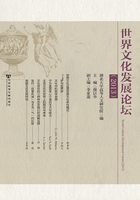
World Culture or Multiple Patterns of World Culture
I am very interested in the topic of this international conference. However, I don't agree with its expressional mode. I would like to make a check on the two phrases-“world culture”and“mainstream cultures”, in order to express the topic of this conference more rationally. I do so is just for arriving at an exact understanding on this topic.
World Culture or Multiple Patterns of World Culture
While one is going to use“world culture”as his research object, he or she will suddenly find out a surprising fact that there is no“world culture”, and it is only an abstract concept, because any culture belongs to some pattern without exception. In other words, there is no culture which can transcend any patterns.
In his introduction of lectures to the history of philosophy, Hegel put forward a very interesting idea that if you want to send a fruit to another person, you will finally find it is impossible, because“fruit”is only an abstract concept which can't be sent to another. That is to say, what can be sent to another is only a concrete kind of fruit, such as apple, strawberry, banana and so on. However,“fruit”can't be sent to another.
In the similar manner, it is not possible for us to investigate“world culture”, and the real objects we may make consideration on are multiple patterns of world culture, such as Asian culture, American culture, Arabian culture, African culture, and so on. Of course, more concrete patterns are Chinese culture, Indian culture, French culture, and so on.
Mainstream Cultures or Mainstream Culture
Obviously, as one uses the metaphor“mainstream cultures”, he must be conscious that this metaphor comes from people's observations of the flowing of different streams. However, according to common sense, it is impossible for any stream to have two or three, even more mainstreams. In other words, a stream has only a unique mainstream. Of course, it is possible for any stream to have many tributaries. Like a stream, any pattern of culture also has only a unique mainstream, so I think we can't say“mainstream cultures”, but we may say“mainstream culture”. That is to say, the concept of culture here is only single, not plural.
Go without saying, there is no so-called united mainstream culture in the world either. In fact, different people always have different perspectives, and when they try to investigate culture, it is necessary for them to offer quite different answers to the question: “what is the mainstream culture in the world? ”In this sense, it is absolutely impossible for us to debate on a mainstream culture approved by everybody, because there is no such united mainstream culture in the world.
Research Method: Speculative or Comparative?
If one talks about“culture”or“world culture”, neglecting its concrete pattern, it is possible for him to see neither cultural multiplicity nor the significance of comparative method among different patterns of culture. As a matter of fact, the comparative method is a useful method in studies of contemporary cultures,because there is no abstract and general culture, but concrete culture belonging to a definite pattern, so what we really need isn't speculation on an abstract and general world culture, but comparison among different patterns of culture in the world.
By the way, comparative method can be divided into the following two different types: one is the dominant comparison, which means researchers openly announce in their papers, reports or books that they are investigating different patterns of culture, using the comparative method; the other is the recessive comparison, which means that researchers never mention such words as“comparison”or“comparative”in their papers, reports or books, but they still in fact use comparative methods, so long as their expressions have reference to different patterns of culture. In this sense, we may say that the comparative method is the only essential method in doing research on contemporary cultures.
